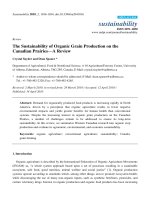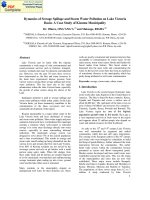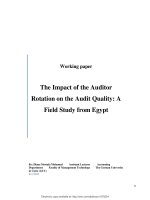Organic gas adsorption on vacancy defect Germanene: A DFT study
Bạn đang xem bản rút gọn của tài liệu. Xem và tải ngay bản đầy đủ của tài liệu tại đây (583.97 KB, 10 trang )
Organic gas adsorption on vacancy defect Germanene: A DFT study
Nguyen Trung Hieu, Vo Van On*
Computational Physics Group and Simulation of Advanced Materials and - Institute of
Application Development- Thu Dau Mot University
Abstract
The adsorption of common organic gas molecules (acetone, toluene and propanol) on vacancy
defected germanene is studied with density functional theory. The results show that acetone,
toluene and propanol are physisorbed on germanene via van der Waals interactions. The
physisorption of gas molecules on germanene opens a band gap at the Dirac point of germanene.
Overall, the different adsorption behaviors of organic gas molecules on vacancy defected
germanene provide a feasible way to exploit chemically modified vacancy defected germanene
for a wide range of practical applications, such as gas sensors and spintronic devices.
I. Introduction
In recent years, two-dimensional (2D) materials have attracted enormous interest of researchers
due to their excellent potential properties for applying in nanotechnology [1–3]. Among them,
graphene has been widely used in various areas [4–7]. However, integrating graphene into
current semiconductor technology is still a large challenge, because it’s inapplicable in silicon/germanium-based semiconductor industry. Many efforts have been made to explore graphenelike 2D materials [8–14], including silicene, germanene, and stanene, which are expected to
overcome the diffculty of application of graphene in future. Nowadays, germanene is regarded as
one of the most emergent and novel 2D material in this nano materials family. A. Nijamudheen
et al. have also reported that buckling plays a very important role in electronic and chemical
properties of germanene [15]. They have concluded that, buckling enhances chemical reactivity
of germanene to form hydrogenated germanene with a direct bandgap, called germanane.
Another study reveals that, value of this direct bandgap for germanane is 3.2 eV, which meets
the requirement of semiconductor device fabrication [16]. This buckled configuration of
germanene is a consequence of mixed sp2 - sp3 hybridization [17]. In addition, germanene is
becoming a leader among them, due to its quantum spin Hall effects (QSHEs) [18–19].
Furthermore, germanene exhibits high charge carrier mobility, which is expected to apply in
high-speed and lowenergy-consumption feld effect transistors [20–21]. In addition, germanene
sheets have been successfully fabricated on the Pt (111), Al (111), Ag (111), and Au (111)
experimentally [22–25]. Functionalized germanene has also been considered for application of
energy storages [19]. Therefore, germanene-based materials are promising candidates for
electrodes in electric double-layer capacitors (EDLCs).
During the synthesis process, the presence of structural defects is unavoidable; hence it is
necessary to examine the influence of defects on the structural, electronic and
transport properties of these materials. Previous studies by Yang at al. [26] indicated that defects
18
and adsorption of metal atoms can improve the quantum capacitance of germanene. However,
the effect of combination of vacancy and adsorption on the quantum capacitance of germannene
has not been investigated for supercapacitors. In this study, a systematic investigation of acetone,
toluene and propanol molecules’ adsorption behavior on vacancy defect germanene is performed
with density functional theory calculations.
II. Computational methodology
All calculations based on the density functional theory were performed using the Vienna ab initio
simulation package (VASP) with PAW potential[27,28]. Because the van der Waals functionals
are expected to be better than van der Waals correction schemes[29-32] we take the van der
Waals interaction into account in all calculations by employing the opt PBE - vdW
functional[32] for the aim to produce the results in better agreement with experiment[33]. The
adsorption configuration, the potential energy surface (PES) and adsorption energy profile were
calculated . To eliminate the interaction between two adjacent periodic images, a vacuum layer
of 20 Å was added into the 4 x 4 supercell of the pristine silicene. A cutoff energy of 450 eV for
the plane-wave basis set and a 3x3x1 Gammacentered K-point mesh were utilized to yield the
energy convergence. All structures were fully relaxed until the maximum Hellmann-Feynman
force acting on each atom is less than 0.03 eV/Å.
III. Results and discussion
3.1 Structure Stability
Before going to explore about the electronic properties of vacancy defected germanene, firstly,
we would like to discuss about structure is most stable after vacancy defected germanene has an
adsorption of gas molecules. Fig. 1 depicts two possible adsorbent sites at germanene. In this
paper, we focus on the adsorption of organic gas molecules on Ge31A configuration. We need to
identify the model which the guest molecules to approach uninhibitedly toward the ribbons to
explore the most preferred configuration. We in turn determine the most appropriate
configuration for each gas molecule: acetone, toluene and propanol. Figure 2 shown the stable
structure of the vacancy defect germanene after adsorbed gas molecules including a) Acetone
(Ge31A-Acetone), b) Toluene (Ge31A-Toluene) and c) Propanol (Ge31A-Propanol).
19
Figure 1: The two stable configurations of vacancy defect germanene
For the comparison of most stable configuration, we first calculated adsorption energy (Ead) of
considered configurations. Following relation has been used for calculating the Ead,
Ead = Etotal- Egas-EGermanene
Where Etotal , EGermanener and Egas are the total energy of the gas molecule, pristine germanene, and
gas molecule adsorbed on vacancy defected germanene, respectively. As per the definition
adopted here, negative adsorption energy exhibits that process is exothermic in nature while the
magnitude signifies thermodynamic stability. Numerical results indicate that adsorption energy
of those samples decreased gradually from -0.29 eV to -0.42 eV with the order Ead(Propanol) >
Ead(Acetone) > Ead(Toluene). In adsorption structures, sample adsorption of Toluene possesses
the highest stability. It is obvious that Toluene adsorption is the most stable one.
Figure 2: The stable structure of the vacancy defect germanene after adsorbed gas molecules
including a) Acetone, b) Toluene and c) Propanol.
20
Figure 3 shows the change of adsorption energy with different adsorption distances. As shown in
Figure 3, we see that the adsorption distance of the samples is about 3.2 Å so it is possible that
the adsorption of the gases under consideration to vacancy defected Germanene is more physical
than chemical adsorption.
Figure 3: Adsorption energy profile of a) acetone, b) toluene and c) propanol gas-adsorbed
vacancy defect germanene
3.2 Electronic properties
After discussing the structural stability in previous section, the electronic properties of vacancy
defected germanene to be discussed in present section for revealing sensing capability towards
acetone, toluene and propanol. To further study the effects of adsorbed organic gas molecules on
the electronic properties of vacancy defected Germanene, the band structures, electronic density
of states (DOS) and charge density difference are calculated for the systems with the adsorption.
Fig. 4 gives the energy band diagrams of different systems, respectively. K, G and M are the high
symmetric k points of the Brillouin zone corresponding to the systems above.
21
Figure 4: Band structure diagrams of a) vacancy defect germanene and b) acetone, c) toluene and
d) propanol gas-adsorbed vacancy defect germanene.
After adsorption of gas molecules, the band gap of germanene has differences between samples.
Band gap of propanol adsorption sample has the largest band gap about 0.052 eV. It is easy to
see that propanol adsorption enlarges the vacancy defected germanene (0.0402 eV) while
acetone and toluene narrow the band gap. The band gap for the defected germanene vacancy
after the adsorption of acetone and toluene is 0.0374 eV and 0.0267 eV, respectively. The very
weak interaction between gas molecules and germanene is also reflected by the sharp peaks in
the DOS of all three samples shown as Fig 5.
22
Figure 5: Total density of states (DOS) of a) acetone, b) toluene and c) propanol gas-adsorbed
vacancy defect germanene.
On the other hand, as see from Fig. 5 that all three cases, there is an overlap between the DOS
lines. This confirms the connection between the gas molecules and the substrate.
To clearly know the bonding character between molecule and germanene, we calculated the
charge density difference (CDD) for all adsorption system, and the isosurface of CDD is
depicted in Fig. 6. It can be seen that there is only a subtle accumulation of electrons in gas
atoms and a depletion of electrons in its three nearest Ge neighbors. The Gas molecule obtains
electrons from germanene . Similar to gas adsorbed graphene, such a subtle charge transfer
indicates that gas molecule is physisorbed on germanene through weak vander Waals interaction.
23
Figure 6: Charge density difference (CDD) of a) acetone, b) toluene and c) propanol gasadsorbed vacancy defect germanene
In order to scrutinize the transfer of charges that happen between the chief component and the
gas molecules at atomistic levels, surface assimilating or adsorption features like Bader charge
transfer (Q). The Bader charge transfer (Q) furnishes us a pathway to realize the charge transfer
that occurs between the base component (Ge31A) and the gas molecules (acetone, toluene and
propanol) and their associated direction of charge traversal [34-39]. The estimated measure of Q
for vacancy defected Germanene and organic gas molecules (acetone, toluene and propanol) are 0.082628 e, -0.06147 e and -0.075697 e, respectively. The negative magnitude observed for all
the adsorption cases confrms the direction of charge traversal to be from vacancy defected
Germanene to organic gas molecules. Moreover, the magnitude of Q is noticed to be higher for
toluene sample.
IV. Conclusions
The first-principles calculations are performed to investigate the structural, energetic and
electronic properties of vacancy defected germanene adsorbed with several organic gas
molecules (including acetone, toluene and propanol). In contrast to graphene, all organic gas
molecules considered bind weak to germanene surface due to the hybridized sp2-sp3 bonding of
24
Ge atoms. We found that all three organic gas molecules is physisorbed on vacancy defected
germanene via van der Waals interaction. In addition, sizable band gaps of (0.0402 eV) are
opened at the Dirac point of vacancy defected germanene through propanol adsorptions
meanwhile, it narrows when adsorbing the other two gases. Overall, the different adsorption
behaviors of organic gas molecules on vacancy defected germanene provide a feasible way to
exploit chemically modified germanene for a wide range of practical applications, such as gas
sensors and spintronic devices.
References
[1] Y.P. Wang, W.X. Ji, C.W. Zhang, L. Ping, S.-F. Zhang, P.-J. Wang, S.-S. Li, S.S. Yan, Twodimensional arsenene oxide: a realistic large-gap quantum spin hall insulator, Appl. Phys. Lett.
110 (2017), 864-442.
[2] M.H. Zhang, C.W. Zhang, P.J. Wang, S.S. Li, Prediction of high-temperature chern insulator
with half-metallic edge states in asymmetry-functionalized stanene, Nanoscale 10 (2018) 20226–
20233.
[3] S.-J. Zhang, C.-W. Zhang, S.-F. Zhang, W.-X. Ji, P. Li, P.-j. Wang, S.-S. Li, S.-S. Yan,
Intrinsic Dirac half-metal and quantum anomalous Hall phase in a hexagonal metal-oxide lattice,
Phys. Rev. B 96 (20) (2017).
[4] K.S. Novoselov, A.K. Geim, S.V. Morozov, D. Jiang, Y. Zhang, S.V. Dubonos, I. V.
Grigorieva, A.A. Firsov, Electric feld effect in atomically thin carbon flms, Science 306 (2004)
666–669.
[5] S. Stankovich, D.A. Dikin, G.H.B. Dommett, K.M. Kohlhaas, E.J. Zimney, E. A. Stach, R.D.
Piner, S.T. Nguyen, R.S. Ruoff, Graphene-based composite materials, Nature 442 (7100) (2006)
282–286.
[6] A.K. Geim, K.S. Novoselov, The rise of graphene, Nature Mater. 6 (2007) 183–191.
[7] A.H. Castro Neto, F. Guinea, N.M.R. Peres, K.S. Novoselov, A.K. Geim, The electronic
properties of graphene, Rev. Mod. Phys. 81 (2009) 109–162.
[8] W. Tao, et al., Emerging two-dimensional monoelemental materials (Xenes) for biomedical
applications, Chem. Soc. Rev. 48 (2019) 2891–2912.
[9] J.K. Lyu, S.F. Zhang, C.W. Zhang, P.J. Wang, Stanene: a promising material for new
electronic and spintronic applications, Ann. Phys. 531 (2019) 1900017.
[10] T. Hartman, Z. Sofer, Beyond graphene: chemistry of group 14 graphene analogues:
silicene, germanene, and stanene, ACS Nano 13 (8) (2019) 8566–8576.
[11] Z. Ni, Q. Liu, K. Tang, J. Zheng, J. Zhou, R. Qin, Z. Gao, D. Yu, J. Lu, Tunable bandgap in
silicene and germanene, Nano Lett. 12 (2012) 113–118.
25
[12] N. Giang, T. Hanh, V. Hoang, Structural and Thermodynamic Properties of
TwoDimensional Confned Germanene: A Molecular Dynamics and Dft Study. Mater. Res.
Express 2019, 6, 086411.
[13] S. Rouhi, H. Pourmirzaagha, A. Farzin, Predicting the Mechanical Properties of MultiLayered Silicene by Molecular Dynamics Simulations. Mater. Res. Express 2019, 6, 085004.
[14] C. Grazianetti, E. Cinquanta, A. Molle, Two-dimensional silicon: the advent of silicene, 2D
Mater. 3 (2016), 012001.
[15] A. Nijamudheen, R. Bhattacharjee, S. Choudhury, A. Datta, Electronic and chemical
properties of germanene: the crucial role of buckling, J. Phys. Chem. C 119 (2015) 3802e3809.
[16] M. Houssa, E. Scalise, K. Sankaran, G. Pourtois, V.V. Afanasev, A. Stesmans,Electronic
properties
of
hydrogenated
silicene
and
germanene,
Appl.
Phys.
Lett. 98 (2011) 223107 (4pp).
[17] P. Miro, M. Audiffred, T. Heine, An atlas of two-dimensional materials, Chem. Soc. Rev.
43 (2014) 6537e6554.
[18] Y. Hu, Y. Mao, Y. Li, J. Ben, J. Zhong, First-principles study on the structure and electronic
properties of Ge2h2 and Ge2li2 nanosheets under electric felds, Phys. B 567 (2019) 95–99.
[19] N. Liu, G. Bo, Y. Liu, X. Xu, Y.i. Du, S.X. Dou, Recent progress on germanene and
functionalized germanene: preparation, characterizations, applications, and challenges, Small 15
(32) (2019) 1805147.
[20] X.-S. Ye, Z.-G. Shao, H. Zhao, L. Yang, C.-L. Wang, Intrinsic carrier mobility of
germanene is larger than graphene’s: frst-principle calculations, RSC Adv. 4 (2014) 21216–
21220.
[21] M.E. Davila, ´ G. Le Lay, Few layer epitaxial germanene: a novel two-dimensional Dirac
material, Sci. Rep. 6 (2016) 20714.
[22] H. S¸ ahin, S. Cahangirov, M. Topsakal, E. Bekaroglu, E. Akturk, R.T. Senger, S. Ciraci,
Monolayer honeycomb structures of group-IV elements and III-V binary compounds: frstprinciples calculations, Phys. Rev. B 80 (15) (2009).
[23] L. Li, S.-Z. Lu, J. Pan, Z. Qin, Y.-Q. Wang, Y. Wang, G.-Y. Cao, S. Du, H.-J. Gao, Buckled
germanene formation on Pt(111), Adv. Mater. 26 (2014) 4820–4824.
[24] H. Oughaddou, et al., Ge/Ag(111) semiconductor-on-metal growth: formation of an surface
alloy, Phys. Rev. B 62 (2000) 16653–16656.
[25] L.-F. Huang, P.-L. Gong, Z. Zeng, Phonon properties, thermal expansion, and
thermomechanics of silicene and germanene, Phys. Rev. B 91 (20) (2015).
26
[26] Q. Xu, X. Si, W.H. She, G.M. Yang, X. Fan, W.T. Zheng, First-principles calculation of
optimizing the performance of germanene-based supercapacitors by vacancies and metal atoms,
J. Phys. Chem. C 124 (2020) 12346–12358.
[27] J. Sivek, H. Sahin, B. Partoens and F. M. Peeters, Phys. Rev. B: Condens. Matter Mater.
Phys., 2013, 87, 085444.
[28] H. Sahin and F. M. Peeters, Phys. Rev. B: Condens. Matter Mater. Phys., 2013, 87, 085423.
[29] G. A. Tritsaris, E. Kaxiras, S. Meng and E. Wang, Nano Lett., 2013, 13, 2258.
[30] J. Wang, J. Li, S.-S. Li and Y. Liu, J. Appl. Phys., 2013, 114, 124309.
[31] C. Li, S. Yang, S.-S. Li, J.-B. Xia and J. Li, J. Phys. Chem. C, 2013, 117, 483.
[32] B. Huang, H. J. Xiang and S.-H. Wei, Phys. Rev. Lett., 2013, 111, 145502.
[33] V. O. Oăzỗelik and S. Ciraci, J. Phys. Chem. C, 2013, 117, 26305.
[34]. A.S. Rad, K. Ayub, Adsorption of thiophene on the surfaces of X12Y12 ( X = Al, B, and Y
= N, P) nanoclusters: a DFT study. J. Mol. Liq. 238, 303–309 (2017)
[35]. A.S. Rad, S.M. Aghaei, V. Poralijan, M. Peyravi, M. Mirzaei, Application of pristine and
Ni-decorated B12P12 nano-clusters as superior media for acetylene and ethylene adsorption:
DFT calculations. Comput. Theor. Chem. 1109, 1–9 (2017)
[36]. R. Chandiramouli, V. Nagarajan, Silicene nanosheet device with nanopore to identify the
nucleobases: a frst-principles perspective. Chem. Phys. Lett. 730, 70–75 (2019) 66. A.S. Rad, D.
Zareyee, V.P. Foukolaei, B.K. Moghadas, M. Peyravi, Study on the electronic structure of
Al12N12 and Al12P12 fullerene-like nano-clusters upon adsorption of CH3F and CH3Cl. Mol.
Phys. 114, 3143–3149 (2016)
[37]. S. Madhumitha, V. Nagarajan, R. Chandiramouli, Adsorption behavior of cytosine and
guanine nucleobases on graphyne nanosheets: a DFT study. Comput. Theor. Chem. 1163,
112514 (2019)
[38]. J.C. Ordaz, E.C. Anota, M.S. Villanueva, M. Castro, Possibility of a magnetic [BN
fullerene: B6 cluster] À nanocomposite as a vehicle for the delivery of dapsone. New J. Chem.
41, 8045– 8052 (2017)
[39]. E.C. Anota, M.S. Villanueva, E.S.M. Castro, Adsorption and possible dissociation of
glucose by the [BN fullerene-B6 ]— magnetic nanocomposite. silico studies, Appl Nanosci. 8,
455– 465 (2018)
27









